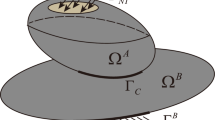Abstract
The use of boundary and volume finite elements in contact problems permits determination of the influence function for bodies of any specific form, with elimination of the indeterminacy at the point of load application; and direct construction of the system of equations for determining the contact regions and the corresponding contact-stress distribution, without the need for complex transformations and without loss of physical significance. As an illustration, the proposed method is used to solve a contact problem.



Similar content being viewed by others
REFERENCES
Kosov, M.G., Kuznetsov, A.P., Tolkacheva, I.M., et al., Modelirovanie tochnosti tekhnologicheskogo oborudovaniya pri avtomatizirovannom proektirovanii (Modeling of Accuracy of Technological Equipment in Automated Design), Moscow: Yanus, 2018.
Volkov, A.E. and Medvedev, V.I., Investigation of multi-pair contact solids with periodic structure, Vestn. Mosk. Gos. Tekhnol. Univ., Stankin, 2015, no. 1 (32), pp. 21–26.
Kosov, M.G., Simanzhenkov, K.A., and Ametova, M.A., Comparative evaluation of the accuracy of the finite element method and the method of response functions, Vestn. Mosk. Gos. Tekhnol. Univ., Stankin, 2018, no. 3 (46), pp. 106–111.
Rivkin, A.V., Kosov, M.G., Sobolev, A.N., and Nekrasov, A.Ya., B-cell model for calculating rigidity of conical interface of tool shank in view error of its manufacture, Vestn. Mosk. Gos. Tekhnol. Univ., Stankin, 2017, no. 3 (42), pp. 31–35.
Kosov, M.G., Sobolev, A.N., and Nekrasov, A.Ya., The information structure of the system of nonsolid modeling, Vestn. Mosk. Gos. Tekhnol. Univ., Stankin, 2015, no. 1 (32), pp. 108–111.
Kats, A.M., Teoriya uprugosti (The Theory of Elasticity), Moscow: Gostekhizdat, 1956.
Zienkiewicz, O.C., The Finite Element Method in Engineering Science, London: McGraw-Hill, 1971.
Sheveleva, G.I., Teoriya formoobrazovaniya i kontakta dvizhushchikhsya tel (The Theory of Forming and Contact of Moving Bodies), Moscow: Mosk. Gos. Tekhnol. Univ., Stankin, 1999.
Shtaerman, I.Ya., Kontaktnaya zadacha teorii uprugosti (The Contact Problem of the Theory of Elasticity), Moscow: Gostekhizdat, 1949.
Kuznetsov, A.P. and Koriath, H.-J., Development of a classification and generation approach for innovative technologies, Procedia Manuf., 2018, vol. 21, pp. 798–805.
Bushuev, V.V., Kuznetsov, A.P., Sabirov, F.S., et al., Precision and efficiency of metal-cutting machines, Russ. Eng. Res., 2016, vol. 36, no. 9, pp. 762–773.
Funding
Financial support was provided by the Russian President in encouragement of young scientists (grant MD-6629.2018.9).
Author information
Authors and Affiliations
Corresponding authors
Additional information
Translated by B. Gilbert
About this article
Cite this article
Kosov, M.G., Kapitanov, A.V. A New Finite-Element Approach to Contact Problems. Russ. Engin. Res. 39, 1053–1056 (2019). https://doi.org/10.3103/S1068798X19120128
Received:
Revised:
Accepted:
Published:
Issue Date:
DOI: https://doi.org/10.3103/S1068798X19120128




